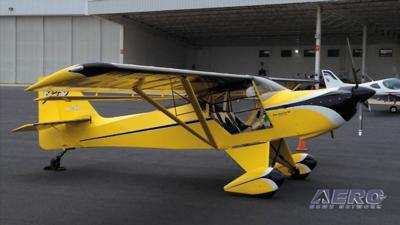Tue, Oct 08, 2013
NTSB Data Shows Overall GA Accident Rate Remained Flat
The number of experimental category aircraft fatal accidents fell by 25 percent in fiscal year 2013 according to FAA figures. Year-to-year fatal aviation accidents involving experimental aircraft totaled 55 during FY 2013, down from 73 in 2012. Lives lost this year totaled 70 people compared to 85 in 2012 - an 18 percent decrease.

The FAA sets "not to exceed" guidelines for fatal accidents every year as part of a 10-year accident reduction plan. The not-to-exceed goal for all experimentals in 2013 was 69 fatal accidents, so in 2013 the total was 14 accidents under that goal. Within that total, the number of fatal accidents for experimental amateur-built aircraft fell by 30 percent, from 50 in 2012 to 35 in 2013. Meanwhile, fatal experimental LSA accidents were down from 11 to eight.
"We are cautiously optimistic that these figures represent many of our safety initiatives starting to take hold in the E-AB community," said Sean Elliott, EAA vice president of advocacy and safety. "EAA has been working hard to promote transition and recurrent training, and we expanded the safety section of Sport Aviation to include monthly flight testing articles by EAA members with a strong flight test background.
"We hope that by encouraging builders and pilots who purchase E-AB aircraft to seek out the best training and information available, we can help those in our community avoid some of the most common accident causes."

While initial accident totals are available immediately at the end of the federal fiscal year, it takes the FAA up to two years to compile and analyze data that creates the accident rate - which is the number of fatal accidents in relation to hours flown. Interestingly, while the number of fatal accidents for experimental category aircraft plummeted, the number for the entire GA fleet was flat, according to the most recent NTSB data available.
"While we cannot yet calculate the most recent accident rate for E-AB and standard category aircraft, we think it is encouraging that the raw E-AB figures fell dramatically while as far as we know the rest of the GA segment stayed relatively flat," Elliott said. "This tells us that the E-AB drop is probably not merely attributable to a drastic reduction in total hours flown - otherwise the total GA figures would have dropped off also."
(Images from file representative of E-AB aircraft)
More News
With Testing Soon Complete, Launch Preparations Begin in Earnest Sierra Space's Dream Chaser has been put through the wringer at NASA's Glenn Armstrong Test Facility in Ohio, but w>[...]
Takeoff Roll The process whereby an aircraft is aligned with the runway centerline and the aircraft is moving with the intent to take off. For helicopters, this pertains to the act>[...]
“We’re proud of the hard work that went into receiving this validation, and it will be a welcome relief to our customers in the European Union. We couldn’t be mor>[...]
"Aircraft Spruce is pleased to announce the acquisition of the parts distribution operations of Wag-Aero. Wag-Aero was founded in the 1960’s by Dick and Bobbie Wagner in the >[...]
IDENT Feature The special feature in the Air Traffic Control Radar Beacon System (ATCRBS) equipment. It is used to immediately distinguish one displayed beacon target from other be>[...]
 Sierra Space Repositions Dream Chaser for First Mission
Sierra Space Repositions Dream Chaser for First Mission ANN's Daily Aero-Term (05.10.24): Takeoff Roll
ANN's Daily Aero-Term (05.10.24): Takeoff Roll Aero-News: Quote of the Day (05.10.24)
Aero-News: Quote of the Day (05.10.24) Aero-News: Quote of the Day (05.11.24)
Aero-News: Quote of the Day (05.11.24) ANN's Daily Aero-Term (05.11.24): IDENT Feature
ANN's Daily Aero-Term (05.11.24): IDENT Feature




